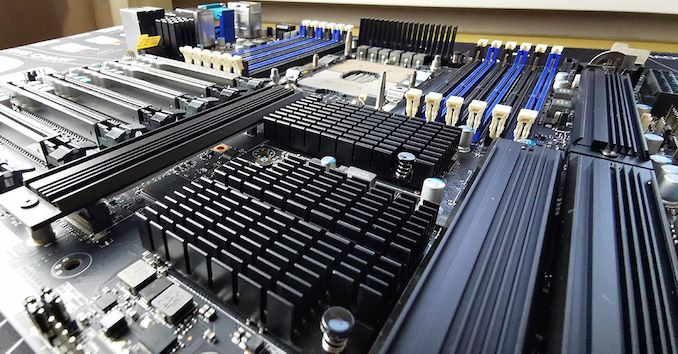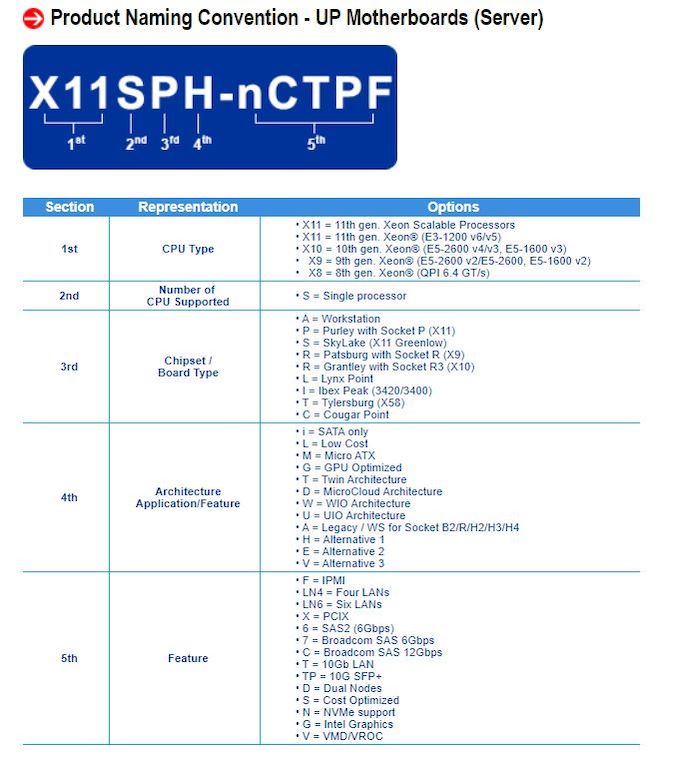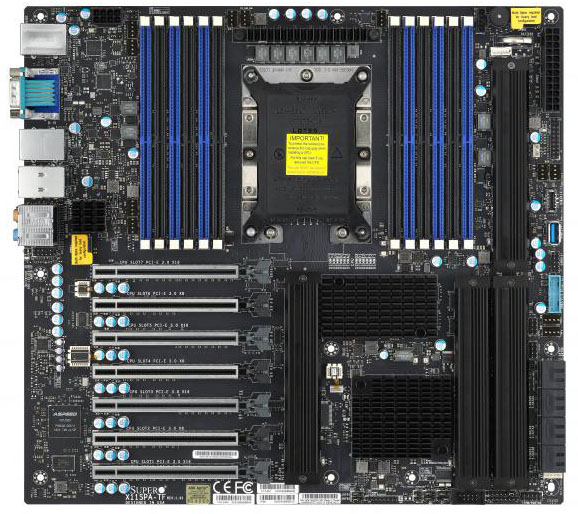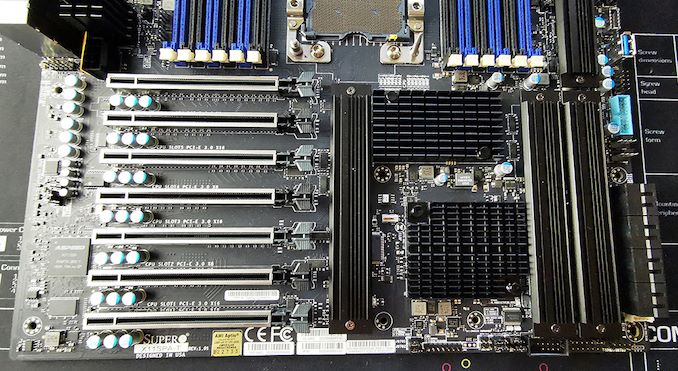The Supermicro X11SPA-T Review: An Impressive Cascade Lake Workstation Motherboard
by Gavin Bonshor on January 24, 2020 9:00 AM EST
Not all motherboards are created equal. Compared to consumer hardware, prosumer level options with workstations opt for different peripheral features, but ultimately it comes down to support. The Supermicro X11SPA-T is a single socket workstation motherboard with a range of high-end features, designed to support both Intel Xeon Scalable CPUs and Xeon-W 3200 series CPUs, but its focus is with the workstation hardware on the C621 chipset. With support for up to 2 TB of DDR4-2933 memory (Xeon W) or 3 TB (Xeon Scalable) across twelve slots, a dedicated ASPEED BMC controller offering IPMI functionality, and seven full-length PCIe 3.0 slots, the Supermicro X11SPA-T looks like one of the premium high-end options for users looking to build a Xeon W-3200 based workstation.
The Supermicro X11SPA-T Overview
Earlier on in the year, Intel dropped its new Xeon W-3200 Cascade Lake based processors which range from its base 8-core Xeon W-3223 model, right up to its Xeon W-3275 with 28 cores and 56 threads, each supporting 1 TB of memory. There is also the W-3275 which supports 2 TB. The primary use for the Intel Xeon-W range is workstations, and Cascade Lake enables certain internal fixes for the Spectre and Meltdown security flaws outlined over the last year. Some of the benefits of the LGA3647 socket Xeon W-3200 processors include six memory channels, support for AVX-512, and 64 PCI lanes on-chip, which allows for four PCIe 3.0 x16 slots to be used.
Supermicro uses its own product naming scheme which it publishes on its website to help users distinguish differences between models. Deciphering the Supermicro X11SPA-T reveals that it's designed for 11th gen (as defined by Supermicro) Xeon Scalable processors, that it's a single socket LGA3647 Purley model, it's on a workstation platform, and that it has 10 gigabit Ethernet.
One board designed to use all of what the Intel Xeon W-3200 family has to offer is the Supermicro X11SPA-T, with a high-end feature set across its large E-ATX PCB. Not every user requires a dual-socket solution, and on paper, the X11SPA-T looks to tick a lot of boxes for users looking for the foundation to a single socket workstation. Not only does it feel it has solid presence, but a full set of DRAM slots, a full array of seven reinforced PCIe slots, four M.2 slots with heatsinks, and as the name suggests, 10 gigabit Ethernet.
As this is a workstation board, it has an ASPEED AST2500 IPMI chip for external control, which is also combined with an onboard D-Sub output, and an integrated Realtek RTL8211E PHY which allows users to access the IPMI via a network when the system has power but isn't switched on. Design-wise, it's the quintessential Supermicro workstation board with a core black theme across the PCB, and heatsinks, which cover the vital areas which need cooling. The twelve memory slots support up to 1 TB or 2 TB depending on the Xeon W-3200 series processor used, meaning 8 x 64 GB + 4 x 128 GB for 1 TB, and 8 x 128 GB + 4 x 256 GB for 2 TB.
For the PCIe lanes, one of the most dominating aspects to the Supermicro X11SPA-T is the seven full-length PCIe 3.0 slots towards the bottom left-hand corner. They operate at x16/x0/x16/x0/x16/x0/x16, or x16/x8/x8/x8/x8/x8/x8 depending on how PCIe devices are installed. Three of the full-length slots share bandwidth with three of the PCIe 3.0 x4 M.2 slots, so there is some muxing involved. There are four PCIe 3.0 x4 M.2 slots, each featuring its own heatsink. Users looking to use these in RAID with Intel (and other approved) drives can do so, as Supermicro includes a VROC RAID key within its software bundle for RAID 0 and 1 support. For SATA drives and devices, there are eight SATA ports which support RAID 0, 1, 5, and 10 arrays.
Looking at the networking on the Supermicro X11SPA-T, there are three Ethernet controllers; one Aquantia AQC107 10 G, one Intel I210-AT Gigabit, and a Realtek RTL8211E PHY dedicated to the boards integrated BMC/IPMI chip. Also on the rear panel is four USB 3.1 G1 Type-A ports, with a single USB 3.1 G2 Type-A, and one USB 3.1 G2 Type-C port. Users can expand on this with a single USB 3.1 G1 headers allowing for two extra Type-A ports, and a single USB 2.0 header which also supports two additional ports. The boards five 3.5 mm audio jacks and S/PDIF are controlled by a Realtek ALC888 HD audio codec.
Overall this board feels substantial. There's nothing fancy like an onboard RAID controller, but for almost everyone who wants to throw the kitchen sink at an Intel workstation system, on paper at least, Supermicro has a very substantial product for the market.
Performance in ~200 Words - Read the Full Review for a Complete Analysis
Comparing performance to previous Intel X299 HEDT motherboards and Intel C246 based models, everything seems on par with what's expected. We were given the W-3235 to test with, which is a 12-core processor, while our comparison reviews used the consumer 10-core. The extra cores of our Intel Xeon W-3235 do perform better in some of our CPU focused tests, but does fall in-line with other models tested in memory heavy tests such as in Blender, and WinRAR. Unsurprisingly in our system tests, power draw is naturally higher than other models previously tested due to the higher core count, and in our non-UEFI POST time test, booting times are much higher than with conventional consumer-focused models due to the added features.
The Supermicro X11SPA-T has a current retail price of $650 at Newegg, and as a result, doesn't have much competition. It's a premium workstation focused model that currently supports all of Intel's Xeon W-3200 product stack, with a lot of headroom for various configurations. If you can find a processor to pair it with, the seven full-length PCIe 3.0 slots are perfect for virtualization tasks, and lots of PCIe 3.0 x4 M.2 and eight SATA ports add plenty of storage capability. Supermicro has seemingly gone all out with its X11SPA-T, but it's time to see how it compares to other Intel HEDT we have tested, including the Supermicro X11SRA motherboard which we tested with the previous generation Intel Xeon W-2155 10-core 20-thread processor.
Read on for more extended analysis.













31 Comments
View All Comments
SSNSeawolf - Friday, January 24, 2020 - link
Gavin, can you comment as to why the W-3235 has a poor showing in some benchmarks, such as Ashes of the Singularity? It loses against it's older cousin, the 7900X, even though it has a slightly faster turbo, much more cache, more memory channels and the same mesh architecture.The only thing I can think of is that the 7900X is LCC Skylake silicon while the W-3235 is HCC, but it doesn't seem that such a big delta can be explained by an extra tile hop or two.
olafgarten - Friday, January 24, 2020 - link
As far as I know it's most likely because AOTS uses a lot of multiprocessing and so the HCC might make a difference therePCWarrior - Monday, January 27, 2020 - link
Three reasons for the difference:1. Looser memory timings (secondary, tertiary) on the workstation Supermicro boards compared to the enthusiast X299 ones with tighter timings. Also, likely looser primary timings (as well as looser secondary and tertiary) due to using 16GB DIMMs (and 6 of them) as opposed to 8GB DIMMS (and only 4 of them).
2. The cascade lake processors have built-in hardware mitigations that are known to have some performance impact. Sure this impact is smaller impact than equivalent software mitigations but larger impact than no security mitigations at all. The 7900X results show in the charts are likely from 2 years ago with no or fewer security mitigations applied.
3. Unlike enthusiast X299 boards that out-of-the box have no power limits and the cpu can turbo to its all-core turbo indefinitely, the Supermicro C246 boards adhere to Intel’s spec so the TDP is enforced after 28 (or so) seconds. So the 3235 in the above results was turboing to its all-core frequency (and we don’t know if it is 4GHZ as it is for the 7900X to begin with) for only 28 seconds - after that its frequency dropped to a value that would make the cpu power consumption not exceed 180W (i.e. equal to the TDP).
P.S: There is a mistake in the article. Specifically, under the Test Bed section it says that the board used was the X11SCA-W (instead of the X11SPA-T that this review is supposedly about). It also says that the RAM used was 2x16GB Corsair Vengeance LPX DDR4-2400 (run at 2666) which would have been the case for the X11SCA-W (mainstream 1151 socket and dual channel RAM). This board (the X11SPA-T) should have been tested with 6x16GB at 2933MHZ. Clearly the author forgot to fully update the table when he copy-pasted it from the older article about the X11SCA-W.
Tomatotech - Friday, January 24, 2020 - link
Nice to see how the big boys handle it. Most of my work is with mITX systems. Would be lovely to see a reasonably priced SFF mobo with more than 2 RAM slots and more than 1 nvme m.2 slot. There have been some but they’re not cheap.eastcoast_pete - Friday, January 24, 2020 - link
This board is outside my personal needs, but I would love to see a lower-priced good quality consumer ATX board with good VRMs, no LEDs and the appearance of this workstation board at a fair price. Something tells me I wouldn't be the only potential customer. Any takers?Foeketijn - Sunday, January 26, 2020 - link
I even emailed them to ask for a bullet proof no nonsense AM4 board (with official ECC support).otherwise - Tuesday, February 25, 2020 - link
The Asus "WS" boards are directly aimed at this market.watersb - Saturday, January 25, 2020 - link
Wow. Do I build one of these, or go for the Mac Pro?Licky McShmickletips - Saturday, January 25, 2020 - link
Please allow me to correct a small error in your postulation:"Do I build -two- of these, or buy one Mac Pro equivalent?"
Death666Angel - Saturday, January 25, 2020 - link
Do you need MacOS? Go with Apple. Do you just need a good workstation? Build it yourself. :)